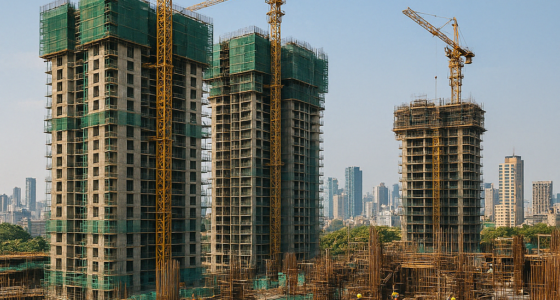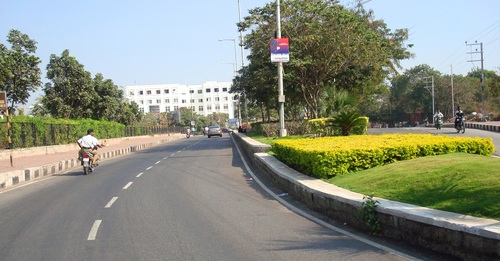Thane, Navi Mumbai, and Suburban Business District North (mainly Andheri-Kurla road) were the preferred office location driving the leasing activity in the Mumbai Metropolitan Region (MMR): Report.
By Varun Singh
Thane, Navi Mumbai, and the Suburban Business District north (mainly Andheri-Kurla Road) remained the preferred office locations during Q2 of 2021.
Mumbai witnessed a net absorption of 0.61 million sq. ft in Q2 2021, an increase of 36% when compared to Q2 2020. The main reason that 2020 saw a dip was the COVID-19 led pandemic, which had put the entire nation under a strict lockdown.
On a sequential basis, the city has recorded more than double net absorption, from the 0.24 million sq. ft as seen in Q1 2021. Nevertheless, net absorption levels remain below the quarterly average of 1.54 million sq. ft witnessed between 2016-19.
According to the report by JLL, in terms of locations, Navi Mumbai, Thane, and SBD North (mainly Andheri-Kurla Road) were the preferred locations, driving leasing activity in Mumbai. In Q2 2021, these three submarkets accounted for nearly 80% of the overall net absorption. Sector-wise, BFSI, manufacturing, and flex space operators dominated leasing activity during the quarter.
The quarter also saw robust new completions of 2.54 million sq. ft with three new projects getting completed. As new completions outpaced net absorption, the vacancy rate increased by 110 bps to 16%. At the same time, overall average city rents in Q2 2021 remained range-bound at Rs 124 – 125 per sq. ft per month.
| Q1 2020 | Q2 2020 | Growth (%)Q2 2020 over Q1 2020 | Q1 2021 | Q2 2021 | Growth (%)Q2 2021 over Q1 2021 | ||||||||
| Net absorption(mn sq ft) | 2.14 | 0.45 | -79% | 0.24 | 0.61 | 149% | |||||||
| New completions(mn sq ft) | 0.84 | 1.45 | 73% | 2.18 | 2.54 | 16% | |||||||
| Vacancy(%) | 12.7 | 13.4 | – | 14.9 | 16.0 | – | |||||||
| Rent(INR/sq. ft/month) | 124.4 | 124.3 | Negligible | 125.3 | 124.3 | -1% |
“As demand for flex spaces grows, flex space operators are expanding their presence in the city. Overall city rents have been stable barring a marginal drop in a few micro-markets. However, it is important to note here that rents are expected to witness steady growth once the market stabilizes post recovery from the impact of COVID-19,” said Karan Singh Sodi – Regional Managing Director, JLL India.
India’s net office absorption stood at 4.39 million sq. ft in the second quarter, representing 32% year-on-year growth in major cities, according to JLL. Given the strict nationwide lockdown across the country in the second quarter, net absorption dipped by 16% versus the previous quarter. However, the quarter-on-quarter drop was lower than 61% during the same period last year when the first wave of the pandemic hit, showing the market’s improved resilience.
“Compared to the big dip that we had seen in the Q2 2020 due to the first wave, the market showed more resilience in Q2 2021 when hit by the second wave. The strength displayed by the office market in India since the pandemic owes much to the fact that the IT/ITeS sector has been largely unaffected by the economic downturn. IT/ITeS occupiers continued to account for a majority of the office leasing activity in 2020 at around 50%. In 2021, we expect the IT/ITeS sector to remain the key occupier group while demand from emerging sectors such as e-commerce, manufacturing, and healthcare is likely to increase further,” said Dr. Samantak Das, Chief Economist, and Head Research & REIS, JLL.
Pre-leasing commitments have been largely intact and downsizing activity by larger corporates has been limited. Occupiers are holding on to spaces with the belief that occupancy at offices will start to improve as the country gets vaccinated. While a timeline for the return to office is still uncertain, the next two quarters are crucial. If the country can keep the third wave in check and ensure that most of the active workforce gets vaccinated, the shift back to the office will be more feasible and sustainable.
With an expected ramp-up in vaccination across the country in the backdrop of a gradual reduction in the number of cases, the second half of the year is expected to witness an increased momentum in office space leasing. Net office absorption in 2021 is likely to remain flat or may grow slightly from the 25.6 million sq. ft achieved in 2020, in case there are no further lockdowns. However, it will remain below the average annual levels of ~35 million sq. ft witnessed over 2016-19.









